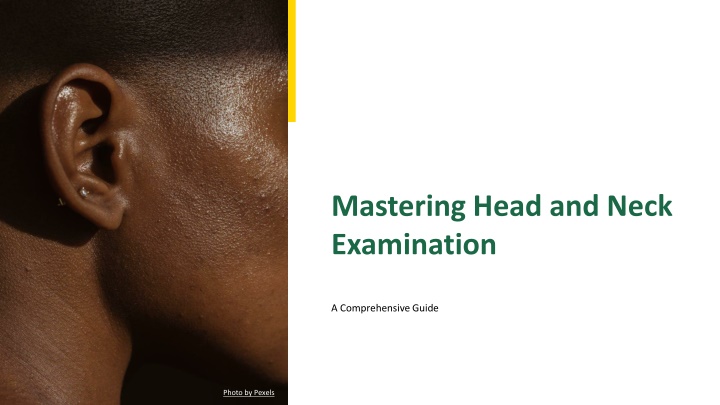
Comprehensive Guide to Mastering Head and Neck Examination
Explore the importance of head and neck examination for assessing health conditions, from inspection to pupillary response, extraocular movements, sensation assessment, muscle functionality, hearing assessment, and identifying malignancies. Learn the key steps, challenges, and benefits of routine examination and patient-centric approaches. Dive into innovations and final thoughts to enhance your examination skills.
Download Presentation

Please find below an Image/Link to download the presentation.
The content on the website is provided AS IS for your information and personal use only. It may not be sold, licensed, or shared on other websites without obtaining consent from the author. If you encounter any issues during the download, it is possible that the publisher has removed the file from their server.
You are allowed to download the files provided on this website for personal or commercial use, subject to the condition that they are used lawfully. All files are the property of their respective owners.
The content on the website is provided AS IS for your information and personal use only. It may not be sold, licensed, or shared on other websites without obtaining consent from the author.
E N D
Presentation Transcript
Mastering Head and Neck Examination A Comprehensive Guide Photo by Pexels
01 Introduction to Head and Neck Exam Table of Contents 02 Importance of Inspection 03 Pupillary Response 04 Extraocular Movements 05 Sensation Assessment 06 Muscle Functionality 07 Hearing Assessment 08 Identifying Malignancies 09 Documentation Importance 10 Routine Examination Benefits 11 Challenges in Examination 12 Importance of Training
13 Patient-Centric Approach Table of Contents 14 Innovations in Examination 15 Final Thoughts 16 Thank You!
1 Introduction to Head and Neck Exam Understanding Basics The head and neck examination is crucial for assessing various health conditions. This exam evaluates size, shape, and any lesions present on the external ear. It's essential to build a routine to ensure all aspects are covered. A thorough assessment helps in early diagnosis and treatment. Photo by Pexels
2 Importance of Inspection First Impressions Matter Inspecting the face can reveal signs of syndromic facies and tumors. Look for skin lesions that may indicate underlying health issues. This step is vital as it sets the tone for the entire examination. Observations made can guide furtherinvestigative steps. Photo by Pexels
3 Pupillary Response Checking Cranial Nerves Evaluating pupillary response tests cranial nerves II and III. Abnormal responses can signal underlying neurological conditions. This simple test provides critical information for diagnosis. Ensure properlighting for accurate observation of responses. Photo by Pexels
4 Extraocular Movements A Window to Health Assessing extraocular movements involves cranial nerves III, IV, and VI. Malignancies or infections can impair these movements. This assessment reveals potential neurological dysfunction. Note any limitations to direct furtherinvestigations. Photo by Pexels
5 Sensation Assessment Touch That Matters Testing light touch sensation assesses cranial nerve V. Abnormal sensations can indicate facial fractures or tumors. This important step should not be overlooked during the exam. Establishing routine helps in consistent evaluations. Photo by Pexels
6 Muscle Functionality Facial Expressions Unveiled Facial expressions are tested throughcranial nerve VII. Patients are asked to raise eyebrows and smile. Weakness is evaluated using the House-Brackmann scale. Facial paralysis can originate from various abnormalities along the nerve path. Photo by Pexels
7 Hearing Assessment Rinne and Weber Tests Hearing is evaluated primarily using Rinne and Weber tests. These tests assess the function of cranial nerve VIII. Normal hearing indicates equal perception across both ears. Testing helps differentiate between conduction and sensorineural hearing loss. Photo by Pexels
8 Identifying Malignancies Be Aware Look for abnormalities that may indicate malignancies. Early detection can significantly improve treatment outcomes. A thoroughhead and neck exam is key to patient health. Stay vigilant and report any unusual findings promptly. Photo by Pexels
9 Documentation Importance Record Findings Accurate documentation of findings aids in tracking patient health. It provides a reference for future examinations and treatments. Document all abnormalities and patient responses systematically. Clear records enhance communication among healthcare providers. Photo by Pexels
10 Routine Examination Benefits Stay Consistent Following a routine ensures no aspect of the exam is missed. It builds a pattern that can lead to improved diagnostic accuracy. Consistency fosters trust between patientand examiner. A structured approach enhances overall patientcare. Photo by Pexels
11 Challenges in Examination Be Prepared Some patients may present with complex cases requiring expert assessment. Time constraints can hinderthoroughexaminations. Stay alert to adapt the exam based on patientneeds. Utilize resources effectively to overcome challenges. Photo by Pexels
12 Importance of Training Sharpen Your Skills Ongoing training is vital for mastering the head and neck exam. Workshops and seminars can enhance practical skills. Education keeps healthcare professionals updated on best practices. Initial and continued training can improve patientoutcomes. Photo by Pexels
13 Patient-Centric Approach Care Beyond Exam Engaging with patients builds trust and cooperation during exams. Listen to patientconcerns to address their needs effectively. Involve patients in the examination process for better results. A holistic approach leads to improved patient satisfaction. Photo by Pexels
14 Innovations in Examination Stay Ahead New technologies are enhancing head and neck examinations. Telemedicine is becoming an essential tool for remote evaluations. AI and machine learning can assist in diagnosis and documentation. Embrace innovation to streamline patientcare processes. Photo by Pexels
15 Final Thoughts Reflect and Review A comprehensive head and neck examination is crucial for healthcare. Each step plays a significant role in patientassessment. Continuous learning and adaptationare key to success. Stay committed to excellence in patientcare. Photo by Pexels
16 Thank You! Appreciation Note Thank you for your attention and participation in this presentation. We hope you found the information valuable and insightful. Your commitment to mastering the head and neck examination is admirable. Together, let s strive for improved patientcare and outcomes! Photo by Pexels
